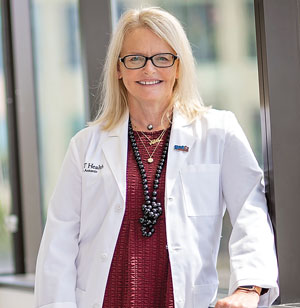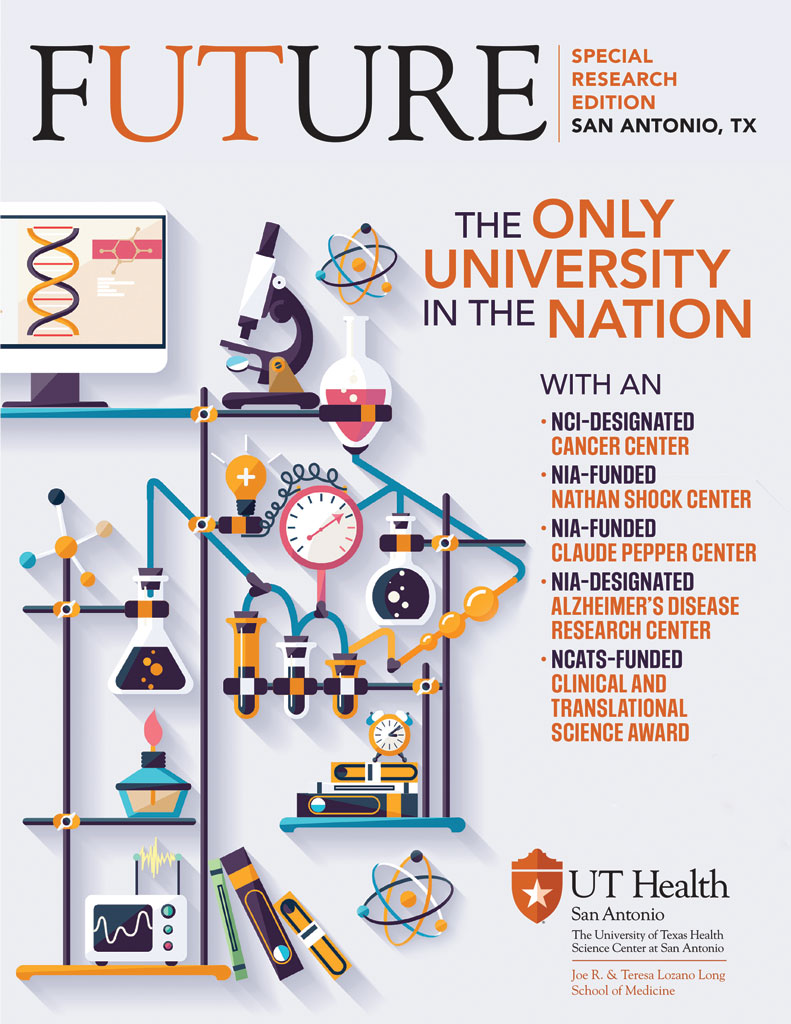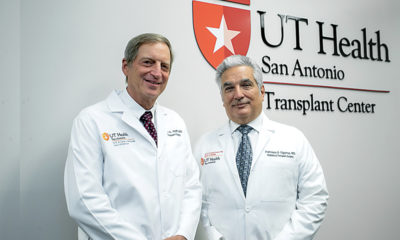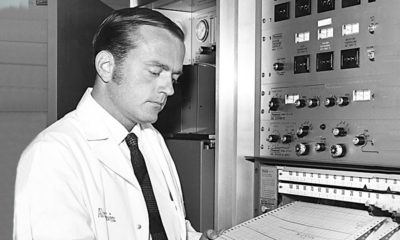New Progress in the Substance-Use Epidemic

By Michael Seringer
Opioid antagonists, such as naloxone, effectively block the effects of opioids, and can rescue overdoses, saving lives. However, most opioids have a duration of action longer than naloxone and other opioid antagonists, which results in re-narcotization—a return to the potentially toxic effects of the opioid, such as suppression of breathing.
“Someone is rescued, and they seem fine. As the naloxone wears off and the [longer-acting] opioid they took is still there, it begins to show its effects again. Respiratory depression kicks in, and they can die,” said Charles France, PhD, professor of pharmacology and of psychiatry and behavioral sciences and an expert in substance use disorders. “This is a very real problem.”
When James Woods, PhD, professor of pharmacology in the Joe R. and Teresa Lozano Long School of Medicine, retired from the University of Michigan, he wasn’t ready to give up the opioid fight and was recruited to the pharmacology department at UT Health San Antonio.
Dr. Woods suggested that Dr. France and his colleagues Lisa R. Gerak, PhD, and David R. Maguire, PhD, look into the opioid receptor blocking properties of methocinnamox (MCAM). Several National Institute on Drug Abuse (NIDA) grants later, Dr. France is hopeful this compound will be successful in clinical trials and become a breakthrough treatment for opioid use disorder and overdose.
MCAM has the potential to be a game-changing treatment. Unlike other antagonist compounds, MCAM stays on the opioid receptor for a significantly longer period of time. This “king of the receptor” may be a potent new tool in treating opioid use disorder and may be a superior antagonist when treating fentanyl overdoses, Dr. France said.

“Most drugs like naloxone are constantly binding and unbinding from their receptor and fentanyl is doing the same,” said Dr. France. “That’s not true with MCAM. Once MCAM binds in this receptor, we are pretty convinced that it doesn’t come off. At least it changes it in a way that is no longer accessible to a fentanyl-like drug.”
The Potential for MCAM to Save Lives
Dr. France, Jennifer Potter, PhD, MPH, interim vice president for research, and other researchers are working diligently to get MCAM from the lab to the clinic because of the drug’s potential to save lives. Research into drugs such as MCAM traditionally has not been the goal of academic pharmacology centers. However, the severity of the substance use crisis has demanded the expertise of neuropharmacology, prioritizing drug discovery.
“Historically, academic pharmacology departments have not been in the business of discovering drugs,” said Alan Frazer, professor and former chair of the Department of Pharmacology. “We were more interested in the systems on which drugs work, identifying potentially novel targets for even better drugs.”
Dr. Frazer’s commitment to building a diverse team of investigators working on innovative research created the conditions for UT Health San Antonio’s current success in neuropharmacology. Measured by National Institutes of Health funding, UT Health San Antonio’s pharmacology department is in the same company as the best programs in the country, Dr. Frazer said.
Receptor Kings
Dr. France and Dr. Woods were both experts in neuroreceptor biochemistry. Dr. Frazer realized that new treatments based on opioid receptor biochemistry were the key to responding to the substance-use epidemic. Dr. Frazer recruited both Dr. France and Dr. Woods as initial pillars in the department’s cohesive efforts to address this epidemic. However, he doesn’t want to talk about the important part he played in it.
Instead, Dr. Frazer focuses on the contributions of others—particularly key faculty members he recruited into the Department of Pharmacology. He describes in great detail how their work benefits the fields of neuroscience and neuropharmacology. It becomes clear, however, that Dr. Frazer has had a lot to do with positioning UT Health San Antonio as a leader in researching diseases as wide ranging—yet inextricably linked—as post-traumatic stress disorder (PTSD), depression and substance use. Investigators in each of these areas have targeted specific receptors for new treatments.
When Dr. Frazer left the University of Pennsylvania for UT Health San Antonio in 1993, he joined just a handful of researchers working in pharmacology here. As the 1990s was the Decade of the Brain, and Dr. Frazer’s own research was in the area of neuropsychopharmacology, he saw the need to expand research in this area in the department.
One early recruit was David Morilak, PhD, from a postdoctoral position at Stanford University. Dr. Morilak has developed into an internationally recognized scientist in the area of stress and stress-related diseases, such as PTSD. His research not only has implications nationwide but is very relevant for San Antonio given its large military population. Dr. Morilak became the director of the Center for Biomedical Neuroscience, and the center has flourished and expanded under his leadership.
No one among this group could have predicted what would happen with the release of OxyContin to the market in 1996. Within a few decades, the program that Dr. Frazer and his colleagues built was called on to help solve one of the great public health crises in American history. Thanks to Dr. Frazer’s commitment to cutting-edge research, UT Health San Antonio’s pharmacology department stood ready to answer that call.
A Public Health Crisis
Because of the COVID-19 pandemic we have forgotten the devastating toll that the substance use epidemic has caused. However, the substance use epidemic is only getting worse. People isolated by the COVID-19 pandemic have overused substances to an ever-increasing extent. In 2020, 93,331 people died from opioid-related poisoning in the U.S., according to the Centers for Disease Control and Prevention—the highest number of overdose-related deaths ever recorded. More than 850,000 people have died from substance use disorder since 1999, according to the CDC. The confluence of failed social, health and political policies exacerbated by the COVID-19 pandemic have fueled a staggering increase in overdose morbidity. The combination of stimulants such as methamphetamine and synthetic opioids such as fentanyl have devastated communities across America.

“We are in the middle of what’s called an opioid epidemic, but it’s really a substance use disorder epidemic because there are other drugs that in some respect are even more troubling,” said Dr. France, Robert A. Welch Distinguished University Chair in Chemistry at UT Health San Antonio. “Stimulant drugs like methamphetamine are a big problem, and quite honestly the co-use of opioids and stimulants is very common.”
The lack of treatment options available for stimulant use disorder further confounds the crisis. Drugs such as buprenorphine, methadone, and naltrexone have been approved for opioid use disorder. Yet, there are no approved medications for the growing stimulant problem, making treatment very difficult.
Dr. France said, “It is a very complicated public health problem at all levels, and the stimulant problem is particularly complicated because we have no FDA-approved medications for stimulant use.”
Dr. Potter, professor of psychiatry and behavioral sciences at UT Health San Antonio, believes that opioid-related morbity and mortality is almost entirely avoidable and thus one of the greatest health failures of our time. In reality, too many people lack affordable access to treatment and are victims of the stigma that goes along with substance use, worsening an already difficult crisis, she said.
“One of the greatest tragedies of this public health crisis is even though we have treatments that work and many tools to address substance use and opioid use disorder, people are still dying without adequate care,” she said.
Patients suffering from substance use disorder often feel shame when seeking help from health care providers. Evidence suggests that stigma actually impedes people’s willingness to seek care for this very treatable health condition.
“This shame becomes internalized and prevents people from seeking necessary treatment,” said Dr. Potter, who is recognized nationally as an expert on opioid use disorder. “Stigma is the enemy of public health.”
However, reducing the public stigma of such patients seeking care is fruitless if there are no physicians who will treat them. Dr. Potter is a leader of the Texas Medication for Opioid Use Disorder (TxMOUD), which is the largest training and technical support effort in Texas for opioid use disorder. A $7.2 million contract from the Texas Health and Human Services Commission allowed Dr. Potter to kick off the multi-pronged program to educate medical providers in prescribing evidence-based treatment, manage a network of trained health providers throughout the state, administer funding to providers for patients who are unable to pay, and track the initiative’s success and patient outcomes.
For fiscal year 2022, Dr. Potter and her team have earned $43 million in contracts—a 56 percent increase from fiscal year 2021—for TxMOUD. This includes $18 million to manage treatment services for opioid use disorder and stimulant use disorder, $2.8 million for recovery support services, $1.95 million for technology and virtual recovery support services for substance use disorder, as well as other related services.
ARTT of Coordinating Care
In recognition of the need for more coordinated efforts to combat the substance use crisis, Dr. France and Dr. Potter established the Addiction Research Treatment & Training (ARTT) Center of Excellence at UT Health San Antonio. The ARTT helps unite a diverse group of substance use researchers and clinicians with the goal of developing new ways to treat patients.
The ARTT center is on a mission to find substance use treatments that work, with the goal of progressing compounds from preclinical to clinical trials and ultimately on to commercialization. ARTT will serve as a single destination for cutting-edge treatment and a trusted source of quality information for clinicians treating substance use.
The NIDA T32 grant provides funding for the postdoctoral training program at ARTT. This center is giving a new generation of researchers and clinicians broad experience across several labs and disciplines. It is this breadth of experience that will be required to continue the fight against substance use disorders. The training faculty at ARTT is composed of professors from pharmacology, nursing, endodontics, physiology and psychiatry, providing an interdisciplinary mentoring program for postdoctoral students.
ARTT and UT Health San Antonio are bringing resources, training and research together with the goal of improving substance use treatments and training clinicians on effective strategies of care. Dr. Frazer’s focus on recruiting top talent and his investments in leading research have contributed greatly to the dynamic pharmacology and neuroscience initiatives that exist today.
The ARTT organizes researchers to form the front line of the substance use epidemic, and they are not prepared to yield any ground. Instead, neuropharmacology efforts at UT Health San Antonio are making serious advances in the treatment of substance use disorders.
“I take a little bit of pride in the way the neuroscience initiative has developed,” said Dr. Frazer. “I think the research here is very relevant for South Texas as well as the world in general.”





